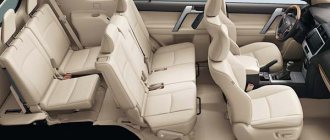"Toyota Prado 150" (full name - "Toyota Land Cruiser Prado 150") was shown in October 2009 at the international automobile exhibition in Frankfurt. The Prado 150 model is the fourth generation of the Land Cruiser family of SUVs from the Japanese concern Toyota. The first series (index 70), second (index 90) and third (120) were produced between 1987 and 2009.
Driving Modes
Since all cars of the Land Cruiser family have a frame structure, the side members for the Toyota Prado 150 were strengthened to create a safety margin. Like the previous 120th version, the new modification has all-wheel drive with constant engagement in the proportion of 40x60 percent on the front and rear axles, respectively. At the same time, the Prado 150 is equipped with a Multi-Terrain system, which adjusts the vehicle’s chassis to four driving modes: on rocks, on gravel, in sticky mud and in deep snow. The machine has manual differential locking on both axles.
Other problems and malfunctions
The paintwork on the Prado body is not resistant enough to external influences, as on most current cars. Chips on the hood are not uncommon, and the metal begins to bloom. Sometimes red dots can be found on the trunk door or at the bottom of the front doors (from the inside).
In cars of the 2nd restyling (from 2021), scuffs or chips of the paint around the headlight (on the wings and bumper) are often found. The reason is a design flaw - there is practically no gap between the elements.
It very quickly loses its luster and the chrome coating of the radiator grille and trim on the rear door begins to peel off.
In winter, the tailgate latch often stops functioning: moisture gets under the shock absorber cover and tears it off when it is opened.
With age, body supports give out - bushings rot, and silent blocks sag. The front supports have to be updated more often. The cost of a complete body kit is about 9,000 rubles.
Some Toyota Land Cruiser Prado owners were puzzled by the “shaky light” of xenon headlights. Fogging of the front view camera optics was also encountered.
Extraneous sounds in the interior of an SUV are not uncommon, especially in an unheated interior. A common problem with diesel versions is a cricket in the lower right corner of the windshield. One of the reasons is the outer plastic trim at the bottom of the glass. The creaking goes away after gluing it. Dealers are well aware of the problem. Another reason is vibration of the right front fender. In this case, it is necessary to bend the metal profile on the inside of the wing.
Some owners note the presence of squeaks in the driver's seat and rattling of the back of the rear seat.
The insufficient quality of the leather upholstery of the seats, steering wheel and silver plastic inserts on the steering wheel and automatic transmission knob contributes to the “misperception” of the Toyota Land Cruiser Prado. They relatively quickly acquire traces of abrasions (after 20-40 thousand km).
At high mileage, there are cases of whistling when the heater motor is turned on. Due to the destruction of the fragile plastic stopper, the front passenger's climate control knob may fall through.
Sometimes you also have to change the steering column cable (snail) - the buttons on the steering wheel stop working and errors appear in the security systems. The original “snail” is available for 20,000 rubles, the Chinese analogue is much cheaper - from 1,000 rubles.
Mentions of generator malfunctions were noted at mileages of more than 400-500 thousand km.
Advantages
Toyota Prado 150 (diesel) is considered a privileged modification. The car, in addition to standard devices, is provided with an additional set of accessories, such as an engine starting system without an ignition key, reverse video review, pre-contact sensors on the entire rear of the car, and a 9-way audio system with a six-disc changer. The Toyota Prado 150 (diesel), the technical characteristics of which did not leave much to be desired, became increasingly popular.
Interior
The interior space of the car leaves the impression of comfort and at the same time a rationally arranged room in which there is nothing superfluous. The high seat gives the driver a good view, and the passenger seats are slightly reclined for added comfort. The central panel is presented in the form of a wide console; it houses dozens of instruments and sensors. In the middle part there are auxiliary devices, for example a clinometer, which determines the position of the car in relation to the horizon line. The limit values of this device are 40 degrees; after passing the red mark, the siren turns on. Nearby is a multifunctional unit of instruments, consisting of a thermometer, altimeter, barometer, average speed counter, and timer.
Transformation capabilities
The level of comfort in the car is maintained by numerous niches, tables, cup holders and shelves retractable into the seat backs. The interior can be transformed into a full-fledged cargo compartment. To do this, you need to fold the third row of seats with a turn in a vertical plane, as well as the second row of seats. The result is a perfectly flat platform for various loads.
Toyota Prado 150, characteristics
Cars for export to Arab countries were equipped with plug-in all-wheel drive, and European modifications were carried out according to the scheme of constant engagement of all four wheels. On cars for Europe, the Thorsen system was installed, distributing torque between the axles in a ratio of 40x60 percent. At the same time, the Torsen differential was blocked directly if necessary, and then the vehicle's cross-country ability increased to one hundred percent.
Dimensional and weight parameters:
- wheelbase - 2790 mm;
- car length - 4760 mm;
- height - 1880 mm;
- width - 1885 mm;
- ground clearance, ground clearance - 220 mm;
- luggage compartment capacity - 1840 liters;
- curb weight - 2090 kg;
- total weight - 2475 kg;
- fuel tank capacity - 97 liters;
- maximum speed - 195 km/h;
- fuel consumption per 100 kilometers, in mixed mode - 9.8 liters;
Options
The vehicle's package, regardless of its export destination, included the HAC-Hill Start Assist Control system, thanks to which the car could move away while on an incline of up to 32 degrees. Also, if necessary, a similar option for descent DAC-Downhill Assist Control was included. For a frame SUV, this ability was especially valuable, since almost all the roads on its route are replete with descents and steep ascents. In addition to these two complex systems, the car had VSC course stability adjustment and electronic optimization of both suspensions - TEMS Toyota Electronic Modulated Suspension. A more active analogue of ABC traction control was also used under the designation A-TRC.
The vehicle configurations in terms of current equipment are defined in four options:
- Entry.
- Legend.
- Prestige.
- Executive.
The first is considered basic and includes 17-inch titanium alloy wheels, climate control, audio system, fabric seat upholstery and tire pressure monitors.
The Legend trim offers nickel-plated body surfaces, power-adjustable and heated outside mirrors, and a leather-wrapped steering wheel and control levers. Multimedia system with 8 speakers with subwoofer, 18-inch wheels.
The Prestige package equips the car with fog lights, rear and side video cameras, electric drives with a memory function in the front seats, a JBL audio player and a navigator.
The most extensive configuration of the SUV is the Executive version, which includes all of the above functions and systems, plus leather interior trim with natural wood trim and Go navigation combined with the Toyota Pre-Crash Safety system.
Technical features
Land Cruiser Prado 150 is an all-wheel drive frame SUV that has received more than one special function to improve performance. KDSS (Kinetic Dynamic Suspension System). This innovative electronics allows you to maintain a horizontal body position when driving over uneven surfaces. It is especially useful when changing lanes while driving on the highway. Body Stability Control modifies the stiffness of the hydraulic anti-roll bars when passing through difficult terrain. It does this very quickly and efficiently.
In addition to KDSS, the CC (Crawl Control) system is installed. It can also be found on premium Lexus SUVs. When driving for a long time along an area with difficult terrain after turning on the CC, the driver does not need to press the brake or gas pedal. The system does this for him, allowing him to concentrate as much as possible on management. A constant speed of up to 10 km/h will be automatically maintained. There are several speed modes that are set manually.
The Toyota LC 150 also has a Multi-terrain Select system. A similar electronic algorithm called Terrain Response can be found on the Land Rover Discovery SE version. The device operates in one of four modes (dirt and sand, stones and gravel, hillocks and potholes, rocks). Control can be done in advance or while driving. The buttons are located on the right side of the steering wheel, which is very convenient.
The principle of operation is that after selecting one of the modes, when you press the accelerator, the torque is optimized and the wheels are braked depending on the terrain. This allows you to easily overcome the most difficult obstacles.
The Toyota Land Cruiser 150 is equipped with an adaptive suspension AVS (Adaptive Variable Suspension), operating in one of three modes: Sport, Normal or Comfort. In combination with AHC (Active Height Control Suspension), a system responsible for the rear air suspension, the SUV can increase the ground clearance under the rear axle in the range of 7 cm (4 cm up and 3 cm down).
Electronic assistants are also provided:
- traction system A-TRC (Active Traction Control);
- hill start assistant HAC (Hill Start Assist Control);
- hill descent assistant DAC (HillDescent Control).
This set, in combination with a frame structure, a permanent all-wheel drive system with a Torsen central differential, forced locking of the central differential with fairly powerful engines, complemented by reliable gearboxes, once again emphasizes the high off-road qualities of the Land Cruiser 150.
Power point
The Toyota Prado 150 engine for the Russian market is presented in several versions. This is a 2.7-liter 1 GR-FE gasoline engine with a thrust of 282 hp. With. and an additional Dual-VVT-i system, as well as a 1KD-FTV turbodiesel with a capacity of 173 hp. With.
Since 2011, gasoline engines with a volume of 2.7 and 3.4 liters and a power of 152 and 178 liters have been installed on the Toyota Prado 150. With. respectively; turbodiesel 1KZ-TE, three-liter volume, 125 hp. With.
The transmission was divided into four categories:
- all-wheel drive with included center differential, index H;
- locked center differential for slippery road surfaces, index HL;
- full neutral - N;
- locked center differential in low gear, for particularly difficult conditions;
There is always a choice
In the minimum configuration, the Toyota Land Cruiser Prado 150 was equipped with three different engines - two gasoline and one diesel. The designers proposed 2TR-FE as the main engine. 16 valve with a size of 2695 cm3 (2.7 l) with a power of 165 hp. with a maximum torque of 246 Nm at 3700 rpm. It was equipped with two gearboxes: a five-position manual and a four-position automatic.
The manufacturer recommends using AI-95 as fuel. Fuel consumption is a very pressing issue for SUV owners. In the city, a car with a manual transmission consumes 12.3 liters per 100 km, with an automatic transmission – 12.7 liters.
In Russia, a Toyota Land Cruiser 150 with a 6-cylinder 4-liter (3956 cm3) 1GR-FE gasoline engine with a power of 282 hp is rarely found. and automatic transmission with 5 positions. They are more in demand in the Middle East. This is explained by great gluttony.
The first modifications of the engine were introduced back in 2002, since then it has been constantly improved and currently produces 377 Nm at 3700 rpm. In 9.2 seconds, the SUV covers the 100 km/h mark, and the top speed is 180 km/h. On the highway, the engine consumes about 12.3 liters, and in the city, 100 km may require from 15 to 18 liters of gasoline, depending on the road situation.
Regarding the diesel variant, it should be noted that it has been replaced. I replaced the 3-liter unit with a 2.8-liter 1GD-FTV engine. Having lost a little in volume, the unit added power, now it is 177 hp. (+20 hp) with a torque of 450 Nm at 2400 rpm. Paired with a 6-speed automatic, the turbodiesel is no doubt powerful. It's perfectly balanced. This is especially noticeable when operating at low speeds.
Compared to the previous engine, about 10% of torque was added. Land Cruiser Prado 150 fuel consumption has decreased by 8% and is now 7.4 liters in mixed mode. Tests show that it can increase to 9-10 liters. Off-road, consumption may increase by 1-2 liters, which is to be expected, but this is not critical.
After restyling, the technical characteristics of the Toyota Land Cruiser Prado 150 improved significantly. This was reflected in the operation of the intercooler; the operating pressure increased to 2200 bar. The fuel combustion and emission system has been modernized. After the modifications, the SUV began to comply with the Euro 5 standard. For European drivers, an even more powerful 1KD-FTV diesel engine with 190 hp is offered.
Brake system
Ventilated discs on all wheels, a dual-circuit hydraulic force wiring diagram with a diagonal sequence, a pressure regulator on the rear calipers that cuts off 50% of the hydraulics when the vehicle is lightly loaded. This short list demonstrates the perfection of the brakes of the Prado 150 SUV. You can add to the list a special sensitivity mechanism with which the brake pedal is equipped. The miniature unit seems to respond to the driver’s actions, asking him to either ease the pressure on the pedal or press harder.
Body Features
The frame design of the SUV provides a high degree of safety. In a collision, the body may be deformed in the area of the tail, that is, thin metal parts that will absorb all the destructive energy. The interior will remain intact. In order to counteract shock loads at the time of an accident, special shock-absorbing side members are installed in the engine compartment, thanks to which the heavy engine will remain almost in place, only lowered due to the existing structure, but will not move inside the car. The safety of the SUV is also enhanced by passive features, six emergency airbags around the perimeter of the cabin, three-point seat belts with pretensioners, shock-absorbing seat backrests and folding headrests.
In addition, deformation zones are provided in the body itself, which should partially neutralize the impact force in a collision. These zones are located at the front and run along the fenders, wheel arches and the partition separating the engine compartment and the car's interior. In the rear of the car, shock-absorbing areas are located behind the bumper, on the wheel arches, rear doors and trunk flaps. In addition, all doors, including the luggage compartment, have built-in box-shaped structures that quite effectively dampen the inertia of an impact. All the active and passive safety features of an SUV together form a fairly effective group to counteract the shock loads that occur at the time of an accident.
Toyota Land Cruiser Prado 150 - model description
General information about the car
Toyota Land Cruiser Prado 150 is the fourth generation of an all-wheel drive frame SUV from Toyota Motor Corporation, which has been produced since 2009 at the Nino plant (Hamura, Japan). Most modifications of the car are five-door and five-seater, but there are also three-door five-seat and five-door seven-seat modifications.
The history of the Prado model began in 1985, when, based on the flagship Toyota Land Cruiser 70, a lightweight three-door version of the SUV was created, which received the LJ71G index (for export models there were the names Land Cruiser II and Land Cruiser Light). The car featured a spring suspension, a low-power engine (85 hp) and was positioned as an all-terrain station wagon. In 1990, a significant modernization of the 70th Land Cruiser was carried out, which also affected the LJ71G - the model received an updated five-door body, three rows of seats and its own name - Toyota Land Cruiser Prado. This model was produced until 1996, when it was replaced by the second generation Prado - 90 series. It was created to counterbalance the highly sought-after Mitsubishi Pajero, which occupied the niche of light and comfortable SUVs. The new Land Cruiser Prado was offered with three-door and five-door bodies, and also featured an independent front suspension. The model turned out to be very successful and within a year it was able to surpass its main competitor in terms of sales in the domestic and foreign markets. The third generation of the SUV (120 series) appeared in 2002 and became one of Toyota’s tools to conquer the European market. Especially for this purpose, the design development was entrusted to the French studio ED2. It also featured a variety of electronic assistance systems. Production of the third generation was completed in 2009.
Model history
The new, latest to date, fourth generation Toyota Land Cruiser Prado 150 was presented at the Frankfurt Motor Show 2009, which once again confirmed the “European” purpose of the model. At the same time, the geography of target markets has expanded significantly compared to the 120th Prado - the car began to be supplied to many countries in Latin America and Australia (more than 175 countries in total). It is not sold in North America - instead, a luxury analogue is offered there - the Lexus GX460. The SUV, like its predecessor, is based on the Toyota 4Runner platform. In 2012, it was decided to launch production of a new generation Toyota Land Cruiser Prado in Russia. Since February 18, 2013, its serial production has been carried out at the Sollers-Bussan joint venture. Planned production volumes - 12,000 pcs. per year, which fully meets the needs of the Russian market. Little is known yet about the successor to the fourth generation Toyota Land Cruiser Prado and its approximate release date. According to Mark Tamplin, vice president of Toyota's luxury division Lexus, the next GX model (and therefore the Prado) will likely switch to a monocoque body instead of a frame structure. In addition, a turbocharged petrol version is expected to appear in the engine range.
Technological features
Compared to the previous version, the Land Cruiser Prado 150 has acquired several interesting systems and design solutions. Thus, a kinetic stabilization system (KDSS) has appeared, which is designed to optimize the performance of the suspension on off-road conditions - on a flat road it provides rigidity, and on off-road conditions it automatically increases the suspension travel. Automated control of the transfer case has also appeared - using a rotating handle. Prado also borrowed the CRAWL system from the flagship Land Cruiser, which performs the function of cruise control when driving slowly off-road - up to 5 km/h with speed changes of only 1 km/h. Additionally, the Multi-Terrain Select electronic assistant is installed, which allows you to change the degree of slipping depending on the selected type of off-road - mud, snow, gravel, stones. An interesting feature of this system is the possibility of an all-round view (Multi-Terrain Monitor) with superimposition of the trajectory of the wheels on the image obtained from video cameras.
Among the minor improvements, the following can be noted: optional installation of a transparent roof; box with refrigerator in the armrest; glasses compartment with panoramic mirror for monitoring blind spots; bottom illumination for ease of landing; possibility of separate opening of rear door glass; presence of a 200V socket in the trunk.
Next photo
Interesting facts
The Chairman of the Communist Party of China - the head of state rides in a Hong Qi HQE limousine, which is created on an extended Toyota Land Cruiser Prado platform. Due to the car's handling and reliability issues, it is typically only used for short distance trips.
According to Toyota marketers, almost a quarter of potential Land Cruiser Prado buyers are women.
Advantages and disadvantages compared to classmates
The main difference between the Prado 150 and its classmates is the presence of a supporting frame. Thanks to this, it is more reliable and durable. Also, the frame design ensures a lower cost of the SUV compared to many others (for example, Volkswagen Tuareg, Land Rover Discovery). Among the disadvantages are large weight, increased fuel consumption, poorer interior equipment, and a side-opening rear door, which requires a large space for loading and unloading.
Numbers and awards
From 2009 to the beginning of 2013, about 50,000 Toyota Land Cruiser Prado 150 were sold in Russia. Since 2010, Prado has topped the ranking of the best-selling full-size SUVs in Russia.
Prado also often tops the lists of the most stolen cars in Russia.
Reviews
Toyota Prado 150 receives only positive reviews. One of the best SUVs in the world, it has long established itself as an extremely reliable, technologically advanced vehicle that meets the requirements of the highest standards. Over the six years of production of the Toyota Prado 150 (diesel) model, feedback from customers has been received only of a positive nature. Toyota cars are traditionally an example of the high quality of Japanese cars, as well as their durability.
Even those owners who prefer to drive a car with a gasoline engine note the undeniable advantages of the diesel version of the SUV. The reliability of the engine, its high repairability, efficiency and low CO2 - all this positively characterizes the Toyota Prado 150 (diesel) model. Owner reviews confirm the high quality of the car.
There is always a choice
In off-road conditions, preference should be given to an SUV equipped with a diesel unit. This choice is explained by the higher torque, especially at low speeds. When overcoming rough terrain, this is more important than engine power.
You shouldn't count on the speed qualities of the Toyota Prado 150. This becomes clear after a test drive, as confirmed by the instrument panel and steering wheel. They have a minimum of information and controls. The car accelerates very slowly when driving along the highway. This is explained by the installed continuous axle and a fairly large unsprung mass. The suspension overcomes unevenness rigidly (after all, it’s a frame), but the cross-country ability remains at a high level.
For use in urban environments, you can give preference to the turbocharged diesel version. In this case, the five-speed automatic transmission demonstrates good dynamic performance. In addition, it is more economical, and in city conditions this is important. Despite high-quality vibration and noise insulation, a diesel engine operates louder than a gasoline unit.
The Toyota Land Cruiser 150 was introduced at the peak of the popularity of the 120 series, when sales of its younger brother exceeded 6 million units. In collaboration with French designers from the ED2 studio, it was possible to combine the individual style of the LC 150 and maintain traditional quality. Today it is supplied to 178 countries around the world. And real connoisseurs of off-road qualities order the first generation Toyota Land Cruiser, which is still manufactured at the Takhara plant.
You can also read on this topic:
Infiniti Q30 will soon be one of the best-selling cars
Infiniti QX80 – restyling of the full-size crossover
Japanese subcompact cross Nissan Kicks performed in aerodynamic motifs
Subaru managers finally appreciated the new generation Crosstrek SUV
Mitsubishi L200 vs Toyota Hilux: who is more reliable?
Share on social networks
Alexander Stepanoff March 4, 2017
Posted in: Japanese cars
Tags: Japanese cars











